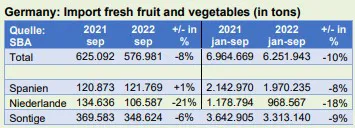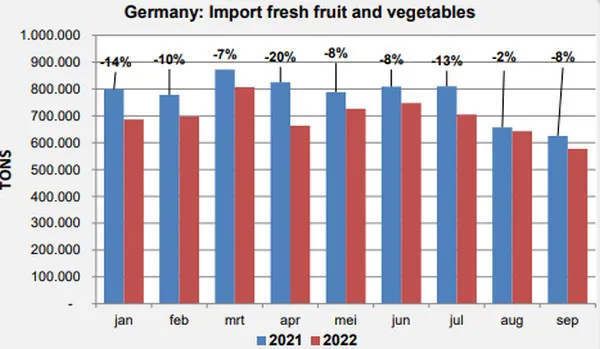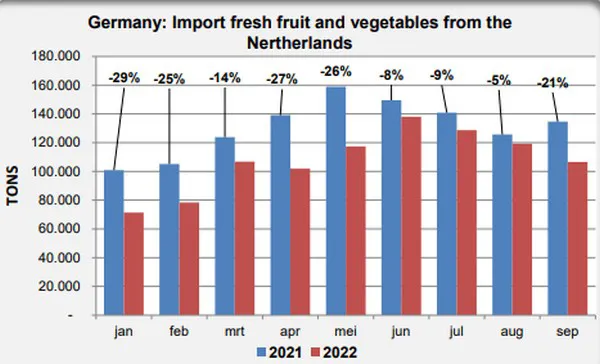In August, German imports of fresh Dutch fruits and vegetables seemed to improve slightly. However, there was a marked decrease, which continued in September. In September, Germany imported 577,000 tons of fresh fruits and vegetables. Last year, in the same month, that was 625,000 tons.
In September, as in the previous eight months, fewer products from primarily the Netherlands entered Germany: 107,000 tons compared to 135,000 tons in September 2021. Spanish imports remained stable in September. Imports from Italy and Poland also decreased considerably in that month. However, more came from Costa Rica and South Africa, but imports from Morocco were low.


84.000 tons fewer tomatoes from the Netherlands
Between January and September 2022, Germany imported 700,000 tons (10%) fewer fresh fruit and vegetable than during the same time last year. Spain sent eight percent less. Imports from the Netherlands fell by as much as 18%, from 1.18 million tons from January to September 2021 to 970,000 tons in the first nine months of this year. That amounts to 210,000 tons fewer imports from the Netherlands.
Tomatoes are the most important Dutch product that Germany imports. This fell from 312,000 tons (Jan.-Sept. 2021) to 228,000 tons in 2022's first nine months. Germany, thus, took 84,000 tons fewer tomatoes from the Netherlands. Total German imports of tomatoes were down 97,000 tons. Imports from Spain remained the same, but Belgium, France, and Italy also sent much less. That was offset by strong growth in Moroccan tomato imports. In the first nine months of this year, that increased from 36,000 to nearly 50,000 tons.

Fewer cucumbers and bell peppers too
During that same time this year, German imports of the two other major Dutch greenhouse products - cucumbers and bell peppers - fell too. That of cucumbers decreased by 11% from 209,000 to 188,000 tons, and that of bell peppers from 109,000 to 103,000 tons. Germany also got fewer cucumbers and bell peppers from Spain. The Netherlands and Spain are quite dominant in both these products' imports.
Almost 100,000 tons fewer bananas
Germany imported far fewer tomatoes and cucumbers in September and since January 2022. Also striking was the sharp drop in banana imports. In this year's first nine months, that dipped by 8% from 1.08 million to 990,000 tons. During that period, imports of other important products like watermelons, apples (a small plus in September), oranges (+12% in September), and onions were also down. Grape and peach imports did rise slightly.
Click here for the background figures.
For more information:
Jan Kees Boon
Fruit and Vegetable Facts
Website: www.fruitandvegetablefacts.com
Email: fruitvegfacts@gmail.com
